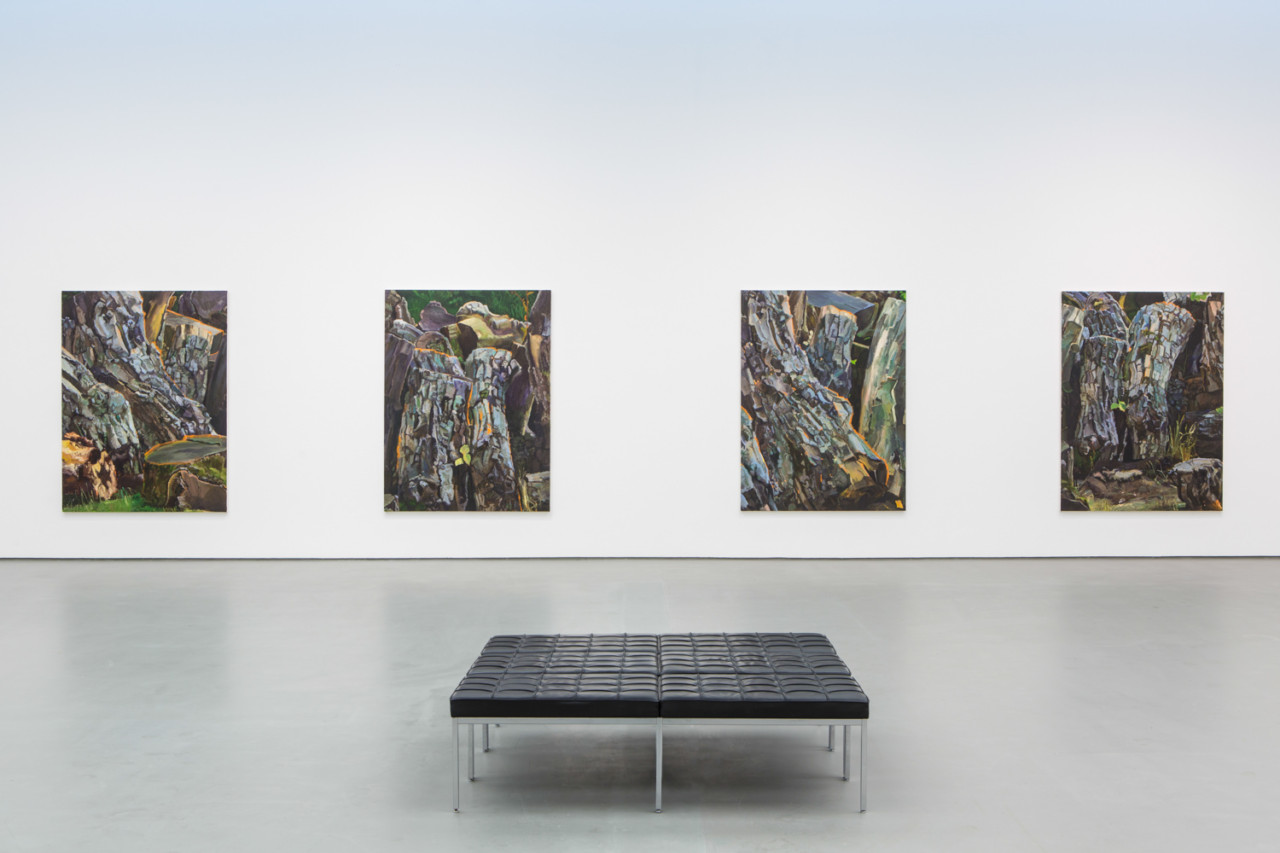


Simon Ling, installation view, Towner Art Gallery. Photographer: Rob Harris
At the end of last week, I braved the icy winds blowing in off the sea to visit the Towner Art Gallery and catch a solo show by Simon Ling that features paintings from the last two years. Yet again, I am afraid I am drawing your attention to an exhibition that is about to close. I can only encourage you to think about how bracing a brisk winter walk would be this weekend, and there is nothing like the English coast at this time of year to tune the eye to the finest modulations of colour, texture and tone.
You are quite likely to come across Simon Ling at his easel in the streets of East London, where he made the run-down shop fronts and awkward, interstitial spaces the subject of his penetrating focus for many years. Although he is mainly London-based now, Ling grew up in Pembrokeshire and maintains a studio on the borders of Wales. In this new show, there is a striking group of paintings made there, building on a body of work which will be familiar to anyone who saw his show at Greengrassi in London in 2018.
The scale of Ling’s paintings has increased dramatically in recent years, and these new works measure over 2m in height, emphasising the monumentality of their subjects. The handling of paint has evolved too – away from the slicker surfaces and meticulous detailing of a decade ago, and towards a more robust, and frankly sculptural, rendering of volume and mass. The results are exhilarating.
Close-cropped treatment of a tumbled woodpile gives each craggy log a powerful presence; the tectonic facets of the cracking bark articulating surfaces that vividly translate the sensation of touch through that of sight. While it might be tempting to understand Ling’s work within an English landscape tradition, his painting is as concerned with revealing the functioning of our ‘perceptual equipment’ as that of Bridget Riley.
Underpainting in fluorescent orange paint has been a characteristic of Ling’s work for years, the colour vibrating on the edges of each composition, lending them an almost hallucinogenic quality. In these new paintings the contrast between this glowing orange and the dark tones of the wood is even greater – the logs appear as if supernaturally irradiated. The dark voids that draw the eye beyond the foreground recede into infinite, inky depths.
Three small scale works on board, in tones of grey, feature intensely rendered details of the landscape around the 2012 Olympic Park. A fragment of concrete flyover cuts across a view of the thickly tree-lined River Lea; a detail of rushes at the river’s edge captured at dusk, black reflections in still water are delivered in quick, loaded brushstrokes. Engaging with these little paintings forces you to move in close, to look extra hard. Contrary, perhaps, to expectation of this subject matter, they entirely resist sentimentality.
Alongside the work from nature, Lings studio practice uses complex compositions of found and constructed objects to create highly distinctive still lifes. He ramps up the sense of a puzzle in the works at Towner by approaching each painting in the most intriguing way. There are two works here, each composed of sixteen individual panels.
In one piece, the artist has started with the lower left-hand panel, rendering that part of the composition before moving on to the panel above and so on, progressively spiralling in towards the centre of the image. In the second work, he started at the centre of the composition and spiralled outwards to the edges. This modular process is not immediately apparent, but the result is visually unbalancing. The multiple panels fragment the image, making it challenging to interrogate the subject matter in front of you. The shifting gaze of the artist as his eye moves across the composition is translated into small shifts in relative scale, creating an undefinable sense of strangeness.
In order to avoid overlaying his works with any suggestion of narrative, Ling does not give his paintings descriptive or allusive titles. Nevertheless, I had Saint-Saens’ Danse Macabre playing in the back of my mind as I looked at the final two works in the show. Once again, these are multi-panel works, too dynamic for me to use the word still life for them, though they are also compositions from the studio.
The first work towers over the viewer at the entrance to the gallery, a skeleton pictured from four different view-points, jack-knifing in poses reminiscent simultaneously of Marcel Duchamp’s Nude Descending a Staircase and Iggy Pop. The viewer is drawn into the cascading diagonal composition, the filmic jump-cuts as Ling renders the shifting of his perspective in repeating elements. Like the other studio-initiated compositions, these works communicate the act of painting in real time. Simon Ling gives the act of painting what he sees a vivid sense of urgency.
The newly reconfigured galleries at the Towner offer beautifully proportioned spaces for substantial solo exhibitions such as this. With Anne Hardy’s curated show from the Arts Council Collection and one-person shows by Carey Young and Dineo Seshee Bopape coming up this year, this is a programme to keep a close eye on.
Caroline Douglas
Director
Towner Art Gallery, Devonshire Park, College Road, Eastbourne BN21 4JJ. Open Tuesday-Sunday 10.00-17.00. Exhibition continues until 27 January 2019. www.townereastbourne.org.uk